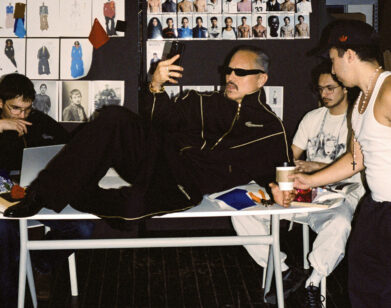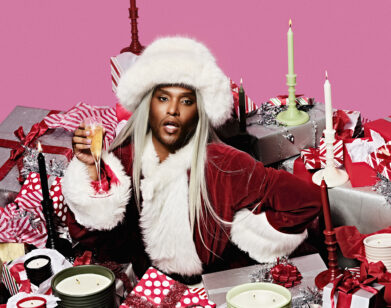One Week in Copenhagen

Danes are renowned for design, albeit furniture, not fashion. Copenhagen Fashion Week did not necessarily challenge that reputation, but it demonstrated the strong retail potential of a city eager to become a serious hub of the Scandinavian fashion community, while Henrik Vibskov’s spectacular show was reason enough to add Copenhagen to a serious fashion calendar.
 Â
Vibskov staged his surreal show of elegant, realistic men’s and
women’s wear at Sibirien Söndermarken, across the street from the Copenhagen Zoo, deep in a heavily overgrown park. There, two creatures covered entirely in yellow second-skin suits with black polka-dots and cages on their heads, characters from Vibskov’s “The Fringe” project, his collaborative art performance project with artist Andreas Emenius, stood and chatted casually at the park’s entrance. Beyond them, the path to the presentation was lit only by teardrop-shaped nets full of light bulbs. Almost a thousand viewers gathered in dense high grass around a massive fallen tree to watch models wearing the Danish designer’s beautifully constructed loose knit dresses with colorful geometric prints, men’s sweaters with interwoven patterns of smiling alien faces and fluid mini-shirtdresses worn by male and female models whose faces and genders were obscured by blond wigs.
The collection was titled “A Donkey Show,” and peevish live donkeys accompanied three of Vibskov’s models. One of them bit his companion model’s behind. But the animal antics did not upstage the strong fresh colors and easy grace of the clothes.
Â
The week had kicked off pragmatically, with a show by Minimarket held for a thin crowd in the cozy Forum Copenhagen tent outside the 200-designer-strong Gallery International Fashion Fair. Minimarket, the Swedish clothing and accessory brand with a sensible international reputation and accessible price-point, presented a collection of very cute mod skirts, jackets, dresses and cloche hats in tangerine, pistachio, lemon, raspberry and licorice.
Â
Looks from Wood Wood
Â
Casual Copenhagen was best represented at Carin Wester and Wood Wood. Wester dressed models like hung-over Audrey Hepburns from the 80s. The girls wore tussled platinum hair and slinky black, red, or tan dresses thrown over visible lacy bras, like girls grabbing last night’s clothes off the floor. Wood Wood designers Karl-Oskar, Brian Piv Jensen, and Magnus Carstensen presented their collection of preppy menswear via oversized sweaters sporting upside-down letters, fisherman’s jackets, anoraks and boating hats, along with a breezy collection of loose dresses and full mid-length skirts with handkerchief hems, flattering flowing tank tops befitting ballet dancers on a break and high-waisted harem pants. A marching band opened the show and as the residents of the blocked off avenue Peder Hvitfeldts Stræde peered out their windows, a mini-army of chic, comfortable models paraded down the street in unpretentious uniform.
 Â
The next show on the schedule, YDE, offered different look at Danish fashion with evening dresses that local fashion folk described as “Copenhagen’s answer to couture.” Designer Ole Yde sent models across the floor of the Copenhagen City Hall where they posed before Mary, Crown Princess of Denmark, and four rows of guests on a raised platform, like artist’s models for a one-second’s sketch. The hand-sewn silk and organza dresses evoked 80s Ungaro, and the tutu-length, sleeveless white wedding dress covered in bows with a trailing train that closed the show had a breed of glamour associated with Dynasty and beloved by the Danish royal family. (LEFT: AT YDE)
Malene Birger’s show on the docks was even more over-the-top. There, the most commercially successful designer in and from Denmark staged an opulent show of mostly black and white sequins, silk and sheer dresses in various lengths, and sporty little suits.
A midrange version of Birger’s and YDE’s aesthetic walked on the pier of Amager Beach during the showing of the Designers Remix Collection. Under a cloudless blue sky and steps away from nude children scampering in the equally blue Amager Strand, models wore sophisticated metallic silky gold party dresses and harem pants, pastel cocktail dresses, draped gold skirts and sharp black suits with peaked shoulders borrowed from Balmain.
Though Sweden could be spotted from seats at the Remix show, for this reporter, the real link between Denmark and Sweden was at Noma, the Michelin two star restaurant located in a 1742 carriage house on the man-made island of Christianhavn where all food is seasonal, Nordic and exceptional (the undisputed highlight of the week for this writer). Dishes such as a salad of Danish lobster, hip rose root and leaves from lettuce and red currant wine or Danish duck and nasturtiums, grilled august pear and leeks are served on heavy white Danish earthware in an especially designed elegant rustic setting that exemplifies the best of Danish design. (LEFT: AT REMIX)






